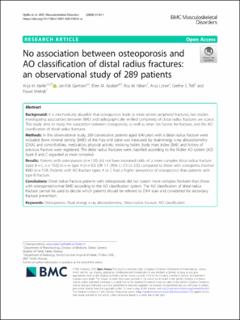| dc.contributor.author | Hjelle, Anja Myhre | |
| dc.contributor.author | Gjertsen, Jan-Erik | |
| dc.contributor.author | Apalset, Ellen Margrete | |
| dc.contributor.author | Nilsen, Roy Miodini | |
| dc.contributor.author | Lober, Anja | |
| dc.contributor.author | Tell, Grethe S. | |
| dc.contributor.author | Pawel, Mielnik | |
| dc.date.accessioned | 2021-02-11T21:07:40Z | |
| dc.date.available | 2021-02-11T21:07:40Z | |
| dc.date.created | 2020-12-12T10:56:03Z | |
| dc.date.issued | 2020-12 | |
| dc.Published | BMC Musculoskeletal Disorders. 2020, 21 1-5. | |
| dc.identifier.issn | 1471-2474 | |
| dc.identifier.uri | https://hdl.handle.net/11250/2727531 | |
| dc.description.abstract | Background: It is mechanically plausible that osteoporosis leads to more severe peripheral fractures, but studies investigating associations between BMD and radiographically verified complexity of distal radius fractures are scarce. This study aims to study the association between osteoporosis, as well as other risk factors for fracture, and the AO classification of distal radius fractures.
Methods: In this observational study, 289 consecutive patients aged ≥40 years with a distal radius fracture were included. Bone mineral density (BMD) of the hips and spine was measured by dual-energy x-ray absorptiometry (DXA), and comorbidities, medication, physical activity, smoking habits, body mass index (BMI), and history of previous fracture were registered. The distal radius fractures were classified according to the Müller AO system (AO) (type B and C regarded as most complex).
Results: Patients with osteoporosis (n = 130) did not have increased odds of a more complex distal radius fracture (type B + C, n = 192)) (n = vs type A (n = 92) (OR 1.1 [95% CI 0.5 to 2.3]) compared to those with osteopenia /normal BMD (n = 159). Patients with AO fracture types A or C had a higher prevalence of osteoporosis than patients with type B fracture.
Conclusions: Distal radius fracture patients with osteoporosis did not sustain more complex fractures than those with osteopenia/normal BMD according to the AO classification system. The AO classification of distal radius fracture cannot be used to decide which patients should be referred to DXA scan and considered for secondary fracture prevention. | en_US |
| dc.language.iso | eng | en_US |
| dc.publisher | BMC | en_US |
| dc.rights | Navngivelse 4.0 Internasjonal | * |
| dc.rights.uri | http://creativecommons.org/licenses/by/4.0/deed.no | * |
| dc.title | No association between osteoporosis and AO classification of distal radius fractures: an observational study of 289 patients | en_US |
| dc.type | Journal article | en_US |
| dc.type | Peer reviewed | en_US |
| dc.description.version | publishedVersion | en_US |
| dc.rights.holder | Copyright The Author(s) | en_US |
| dc.source.articlenumber | 811 (2020) | en_US |
| cristin.ispublished | true | |
| cristin.fulltext | original | |
| cristin.qualitycode | 1 | |
| dc.identifier.doi | 10.1186/s12891-020-03842-w | |
| dc.identifier.cristin | 1859008 | |
| dc.source.journal | BMC Musculoskeletal Disorders | en_US |
| dc.source.40 | 21 | |
| dc.source.pagenumber | 1-5 | en_US |
| dc.identifier.citation | BMC Musculoskeletal Disorders. 2020, 21, 811. | |
| dc.source.volume | 21 | en_US |

